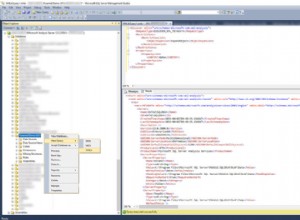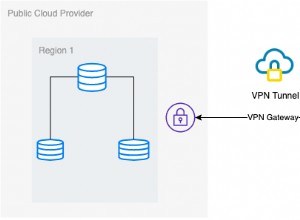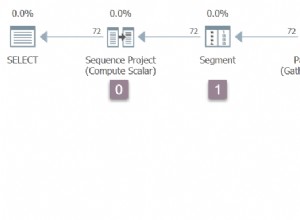Introduzione
Spesso è necessario controllare la crescita di tutte le tabelle e file di tutti i database.
In questo articolo esploreremo un esempio di come automatizzare la raccolta dei dati sulla crescita di tabelle e file di database di SQL Server.
Soluzione
- Crea una vista sulla dimensione di tutte le tabelle per ogni database
USE [DATABASE_NAME] GO SET ANSI_NULLS ON GO SET QUOTED_IDENTIFIER ON GO CREATE view [inf].[vTableSize] as with pagesizeKB as ( SELECT low / 1024 as PageSizeKB FROM master.dbo.spt_values WHERE number = 1 AND type = 'E' ) ,f_size as ( select p.[object_id], sum([total_pages]) as TotalPageSize, sum([used_pages]) as UsedPageSize, sum([data_pages]) as DataPageSize from sys.partitions p join sys.allocation_units a on p.partition_id = a.container_id left join sys.internal_tables it on p.object_id = it.object_id WHERE OBJECTPROPERTY(p.[object_id], N'IsUserTable') = 1 group by p.[object_id] ) ,tbl as ( SELECT t.[schema_id], t.[object_id], i1.rowcnt as CountRows, (COALESCE(SUM(i1.reserved), 0) + COALESCE(SUM(i2.reserved), 0)) * (select top(1) PageSizeKB from pagesizeKB) as ReservedKB, (COALESCE(SUM(i1.dpages), 0) + COALESCE(SUM(i2.used), 0)) * (select top(1) PageSizeKB from pagesizeKB) as DataKB, ((COALESCE(SUM(i1.used), 0) + COALESCE(SUM(i2.used), 0)) - (COALESCE(SUM(i1.dpages), 0) + COALESCE(SUM(i2.used), 0))) * (select top(1) PageSizeKB from pagesizeKB) as IndexSizeKB, ((COALESCE(SUM(i1.reserved), 0) + COALESCE(SUM(i2.reserved), 0)) - (COALESCE(SUM(i1.used), 0) + COALESCE(SUM(i2.used), 0))) * (select top(1) PageSizeKB from pagesizeKB) as UnusedKB FROM sys.tables as t LEFT OUTER JOIN sysindexes as i1 ON i1.id = t.[object_id] AND i1.indid < 2 LEFT OUTER JOIN sysindexes as i2 ON i2.id = t.[object_id] AND i2.indid = 255 WHERE OBJECTPROPERTY(t.[object_id], N'IsUserTable') = 1 OR (OBJECTPROPERTY(t.[object_id], N'IsView') = 1 AND OBJECTPROPERTY(t.[object_id], N'IsIndexed') = 1) GROUP BY t.[schema_id], t.[object_id], i1.rowcnt ) SELECT @@Servername AS Server, DB_NAME() AS DBName, SCHEMA_NAME(t.[schema_id]) as SchemaName, OBJECT_NAME(t.[object_id]) as TableName, t.CountRows, t.ReservedKB, t.DataKB, t.IndexSizeKB, t.UnusedKB, f.TotalPageSize*(select top(1) PageSizeKB from pagesizeKB) as TotalPageSizeKB, f.UsedPageSize*(select top(1) PageSizeKB from pagesizeKB) as UsedPageSizeKB, f.DataPageSize*(select top(1) PageSizeKB from pagesizeKB) as DataPageSizeKB FROM f_size as f inner join tbl as t on t.[object_id]=f.[object_id] GO
- Crea un database specifico e determina una tabella per memorizzare le informazioni sulla crescita di tutte le tabelle del database:
USE [DATABASE_NAME] GO SET ANSI_NULLS ON GO SET QUOTED_IDENTIFIER ON GO SET ANSI_PADDING ON GO CREATE TABLE [srv].[TableStatistics]( [Row_GUID] [uniqueidentifier] NOT NULL CONSTRAINT [DF_TableStatistics_Row_GUID] DEFAULT (newid()), [ServerName] [nvarchar](255) NOT NULL, [DBName] [nvarchar](255) NOT NULL, [SchemaName] [nvarchar](255) NOT NULL, [TableName] [nvarchar](255) NOT NULL, [CountRows] [bigint] NOT NULL, [DataKB] [int] NOT NULL, [IndexSizeKB] [int] NOT NULL, [UnusedKB] [int] NOT NULL, [ReservedKB] [int] NOT NULL, [InsertUTCDate] [datetime] NOT NULL CONSTRAINT [DF_TableStatistics_InsertUTCDate] DEFAULT (getutcdate()), [Date] AS (CONVERT([date],[InsertUTCDate])) PERSISTED, [CountRowsBack] [bigint] NULL, [CountRowsNext] [bigint] NULL, [DataKBBack] [int] NULL, [DataKBNext] [int] NULL, [IndexSizeKBBack] [int] NULL, [IndexSizeKBNext] [int] NULL, [UnusedKBBack] [int] NULL, [UnusedKBNext] [int] NULL, [ReservedKBBack] [int] NULL, [ReservedKBNext] [int] NULL, [AvgCountRows] AS ((([CountRowsBack]+[CountRows])+[CountRowsNext])/(3)) PERSISTED, [AvgDataKB] AS ((([DataKBBack]+[DataKB])+[DataKBNext])/(3)) PERSISTED, [AvgIndexSizeKB] AS ((([IndexSizeKBBack]+[IndexSizeKB])+[IndexSizeKBNext])/(3)) PERSISTED, [AvgUnusedKB] AS ((([UnusedKBBack]+[UnusedKB])+[UnusedKBNext])/(3)) PERSISTED, [AvgReservedKB] AS ((([ReservedKBBack]+[ReservedKB])+[ReservedKBNext])/(3)) PERSISTED, [DiffCountRows] AS (([CountRowsNext]+[CountRowsBack])-(2)*[CountRows]) PERSISTED, [DiffDataKB] AS (([DataKBNext]+[DataKBBack])-(2)*[DataKB]) PERSISTED, [DiffIndexSizeKB] AS (([IndexSizeKBNext]+[IndexSizeKBBack])-(2)*[IndexSizeKB]) PERSISTED, [DiffUnusedKB] AS (([UnusedKBNext]+[UnusedKBBack])-(2)*[UnusedKB]) PERSISTED, [DiffReservedKB] AS (([ReservedKBNext]+[ReservedKBBack])-(2)*[ReservedKB]) PERSISTED, [TotalPageSizeKB] [int] NULL, [TotalPageSizeKBBack] [int] NULL, [TotalPageSizeKBNext] [int] NULL, [UsedPageSizeKB] [int] NULL, [UsedPageSizeKBBack] [int] NULL, [UsedPageSizeKBNext] [int] NULL, [DataPageSizeKB] [int] NULL, [DataPageSizeKBBack] [int] NULL, [DataPageSizeKBNext] [int] NULL, [AvgDataPageSizeKB] AS ((([DataPageSizeKBBack]+[DataPageSizeKB])+[DataPageSizeKBNext])/(3)) PERSISTED, [AvgUsedPageSizeKB] AS ((([UsedPageSizeKBBack]+[UsedPageSizeKB])+[UsedPageSizeKBNext])/(3)) PERSISTED, [AvgTotalPageSizeKB] AS ((([TotalPageSizeKBBack]+[TotalPageSizeKB])+[TotalPageSizeKBNext])/(3)) PERSISTED, [DiffDataPageSizeKB] AS (([DataPageSizeKBNext]+[DataPageSizeKBBack])-(2)*[DataPageSizeKB]) PERSISTED,--shows as the casting is changed [DiffUsedPageSizeKB] AS (([UsedPageSizeKBNext]+[UsedPageSizeKBBack])-(2)*[UsedPageSizeKB]) PERSISTED,--shows as the casting is changed [DiffTotalPageSizeKB] AS (([TotalPageSizeKBNext]+[TotalPageSizeKBBack])-(2)*[TotalPageSizeKB]) PERSISTED,--shows as the casting is changed CONSTRAINT [PK_TableStatistics] PRIMARY KEY CLUSTERED ( [Row_GUID] ASC )WITH (PAD_INDEX = OFF, STATISTICS_NORECOMPUTE = OFF, IGNORE_DUP_KEY = OFF, ALLOW_ROW_LOCKS = ON, ALLOW_PAGE_LOCKS = ON) ON [PRIMARY] ) ON [PRIMARY] GO SET ANSI_PADDING ON GO
TotalPageSizeKB indica la dimensione della tabella.
Il totale di TotalPageSizeKB di tutte le tabelle del database + la dimensione delle tabelle di sistema =la dimensione dei dati del database.
- Determina la procedura per la raccolta delle informazioni:
USE [DATABASE_NAME] GO SET ANSI_NULLS ON GO SET QUOTED_IDENTIFIER ON GO CREATE PROCEDURE [srv].[InsertTableStatistics] AS BEGIN SET NOCOUNT ON; SET TRANSACTION ISOLATION LEVEL READ UNCOMMITTED; declare @dt date=CAST(GetUTCDate() as date); declare @dbs nvarchar(255); declare @sql nvarchar(max); select [name] into #dbs from sys.databases; while(exists(select top(1) 1 from #dbs)) begin select top(1) @dbs=[name] from #dbs; set @sql= N'INSERT INTO [srv].[TableStatistics] ([ServerName] ,[DBName] ,[SchemaName] ,[TableName] ,[CountRows] ,[DataKB] ,[IndexSizeKB] ,[UnusedKB] ,[ReservedKB] ,[TotalPageSizeKB] ,[UsedPageSizeKB] ,[DataPageSizeKB]) SELECT [Server] ,[DBName] ,[SchemaName] ,[TableName] ,[CountRows] ,[DataKB] ,[IndexSizeKB] ,[UnusedKB] ,[ReservedKB] ,[TotalPageSizeKB] ,[UsedPageSizeKB] ,[DataPageSizeKB] FROM ['[email protected]+'].[inf].[vTableSize];'; exec sp_executesql @sql; delete from #dbs where [name][email protected]; end drop table #dbs; declare @dt_back date=CAST(DateAdd(day,-1,@dt) as date); ;with tbl1 as ( select [Date], [CountRows], [DataKB], [IndexSizeKB], [UnusedKB], [ReservedKB], [ServerName], [DBName], [SchemaName], [TableName], [TotalPageSizeKB], [UsedPageSizeKB], [DataPageSizeKB] from [srv].[TableStatistics] where [Date][email protected]_back ) , tbl2 as ( select [Date], [CountRows], [CountRowsBack], [DataKBBack], [IndexSizeKBBack], [UnusedKBBack], [ReservedKBBack], [ServerName], [DBName], [SchemaName], [TableName], [TotalPageSizeKBBack], [UsedPageSizeKBBack], [DataPageSizeKBBack] from [srv].[TableStatistics] where [Date][email protected] ) update t2 set t2.[CountRowsBack] =t1.[CountRows], t2.[DataKBBack] =t1.[DataKB], t2.[IndexSizeKBBack] =t1.[IndexSizeKB], t2.[UnusedKBBack] =t1.[UnusedKB], t2.[ReservedKBBack] =t1.[ReservedKB], t2.[TotalPageSizeKBBack]=t1.[TotalPageSizeKB], t2.[UsedPageSizeKBBack] =t1.[UsedPageSizeKB], t2.[DataPageSizeKBBack] =t1.[DataPageSizeKB] from tbl1 as t1 inner join tbl2 as t2 on t1.[Date]=DateAdd(day,-1,t2.[Date]) and t1.[ServerName]=t2.[ServerName] and t1.[DBName]=t2.[DBName] and t1.[SchemaName]=t2.[SchemaName] and t1.[TableName]=t2.[TableName]; ;with tbl1 as ( select [Date], [CountRows], [CountRowsNext], [DataKBNext], [IndexSizeKBNext], [UnusedKBNext], [ReservedKBNext], [ServerName], [DBName], [SchemaName], [TableName], [TotalPageSizeKBNext], [UsedPageSizeKBNext], [DataPageSizeKBNext] from [srv].[TableStatistics] where [Date][email protected]_back ) , tbl2 as ( select [Date], [CountRows], [DataKB], [IndexSizeKB], [UnusedKB], [ReservedKB], [ServerName], [DBName], [SchemaName], [TableName], [TotalPageSizeKB], [UsedPageSizeKB], [DataPageSizeKB] from [srv].[TableStatistics] where [Date][email protected] ) update t1 set t1.[CountRowsNext] =t2.[CountRows], t1.[DataKBNext] =t2.[DataKB], t1.[IndexSizeKBNext] =t2.[IndexSizeKB], t1.[UnusedKBNext] =t2.[UnusedKB], t1.[ReservedKBNext] =t2.[ReservedKB], t1.[TotalPageSizeKBNext]=t2.[TotalPageSizeKB], t1.[UsedPageSizeKBNext] =t2.[UsedPageSizeKB], t1.[DataPageSizeKBNext] =t2.[DataPageSizeKB] from tbl1 as t1 inner join tbl2 as t2 on t1.[Date]=DateAdd(day,-1,t2.[Date]) and t1.[ServerName]=t2.[ServerName] and t1.[DBName]=t2.[DBName] and t1.[SchemaName]=t2.[SchemaName] and t1.[TableName]=t2.[TableName]; END GOQuesta soluzione può essere modificata per raccogliere dati sulle dimensioni delle tabelle di tutti i database da tutte le istanze richieste di MS SQL Server.
- Definisci la vista in base alle informazioni raccolte:
USE [DATABASE_NAME] GO SET ANSI_NULLS ON GO SET QUOTED_IDENTIFIER ON GO create view [srv].[vTableStatisticsShort] as with d as (select DateAdd(day,-1,max([Date])) as [Date] from [srv].[TableStatistics]) SELECT t.[ServerName] ,t.[DBName] ,t.[SchemaName] ,t.[TableName] ,t.[CountRows] ,t.[DataKB] ,t.[IndexSizeKB] ,t.[UnusedKB] ,t.[ReservedKB] ,t.[InsertUTCDate] ,t.[Date] ,t.[CountRowsBack] ,t.[CountRowsNext] ,t.[DataKBBack] ,t.[DataKBNext] ,t.[IndexSizeKBBack] ,t.[IndexSizeKBNext] ,t.[UnusedKBBack] ,t.[UnusedKBNext] ,t.[ReservedKBBack] ,t.[ReservedKBNext] ,t.[AvgCountRows] ,t.[AvgDataKB] ,t.[AvgIndexSizeKB] ,t.[AvgUnusedKB] ,t.[AvgReservedKB] ,t.[DiffCountRows] ,t.[DiffDataKB] ,t.[DiffIndexSizeKB] ,t.[DiffUnusedKB] ,t.[DiffReservedKB] ,t.[TotalPageSizeKB] ,t.[TotalPageSizeKBBack] ,t.[TotalPageSizeKBNext] ,t.[UsedPageSizeKB] ,t.[UsedPageSizeKBBack] ,t.[UsedPageSizeKBNext] ,t.[DataPageSizeKB] ,t.[DataPageSizeKBBack] ,t.[DataPageSizeKBNext] ,t.[AvgDataPageSizeKB] ,t.[AvgUsedPageSizeKB] ,t.[AvgTotalPageSizeKB] ,t.[DiffDataPageSizeKB] ,t.[DiffUsedPageSizeKB] ,t.[DiffTotalPageSizeKB] FROM d inner join [SRV].[srv].[TableStatistics] as t on d.[Date]=t.[Date] where t.[CountRowsBack] is not null and t.[CountRowsNext] is not null GOQui vorrei attirare la vostra attenzione sul Diff. Se è maggiore di 0, significa che la tabella cresce ogni giorno più velocemente.
La raccolta dovrebbe essere effettuata una volta ogni 24 ore.
Allo stesso modo, possiamo automatizzare la raccolta della crescita dei file di tutti i database utilizzando la seguente vista:
USE [DATABASE_NAME] GO SET ANSI_NULLS ON GO SET QUOTED_IDENTIFIER ON GO select t2.[DB_Name] as [DBName] ,t1.FileId ,t1.NumberReads ,t1.BytesRead ,t1.IoStallReadMS ,t1.NumberWrites ,t1.BytesWritten ,t1.IoStallWriteMS ,t1.IoStallMS ,t1.BytesOnDisk ,t1.[TimeStamp] ,t1.FileHandle ,t2.[Type_desc] ,t2.[FileName] ,t2.[Drive] ,t2.[Physical_Name] ,t2.[Ext] ,t2.[CountPage] ,t2.[SizeMb] ,t2.[SizeGb] ,t2.[Growth] ,t2.[GrowthMb] ,t2.[GrowthGb] ,t2.[GrowthPercent] ,t2.[is_percent_growth] ,t2.[database_id] ,t2.[State] ,t2.[StateDesc] ,t2.[IsMediaReadOnly] ,t2.[IsReadOnly] ,t2.[IsSpace] ,t2.[IsNameReserved] ,t2.[CreateLsn] ,t2.[DropLsn] ,t2.[ReadOnlyLsn] ,t2.[ReadWriteLsn] ,t2.[DifferentialBaseLsn] ,t2.[DifferentialBaseGuid] ,t2.[DifferentialBaseTime] ,t2.[RedoStartLsn] ,t2.[RedoStartForkGuid] ,t2.[RedoTargetLsn] ,t2.[RedoTargetForkGuid] ,t2.[BackupLsn] from fn_virtualfilestats(NULL, NULL) as t1 inner join [inf].[ServerDBFileInfo] as t2 on t1.[DbId]=t2.[database_id] and t1.[FileId]=t2.[File_Id] GO
Risultato
In questo articolo è stato esaminato l'esempio di automazione della raccolta dei dati sulla dimensione e la crescita di tutte le tabelle e i file di SQL Server di tutti i database. Ci fornisce il controllo completo sulla modifica delle dimensioni dei file di database e delle relative tabelle, oltre a prendere misure tempestive per ridurre la tabella o il file, aumentare il dispositivo di archiviazione dati o dividere le informazioni in più dispositivi di archiviazione dati.




